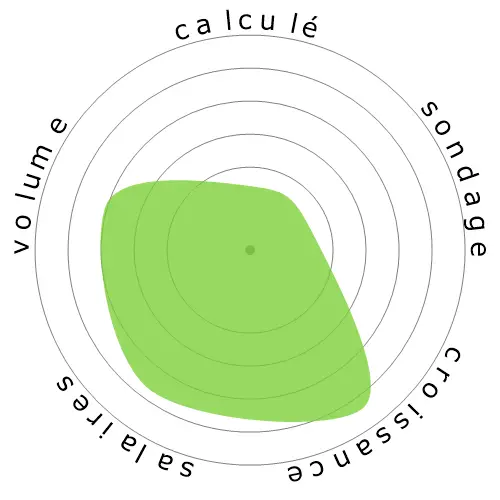Analystes en Intelligence d'Affaires
Les données sur l'emploi ne sont pas spécifiquement disponibles pour cette profession auprès du Bureau des Statistiques du Travail, donc nous utilisons les données provenant de Data Scientists.




Les gens ont également vu
Risque d'automatisation calculé
Risque Élevé (61-80%) : Les emplois dans cette catégorie font face à une menace significative de l'automatisation, car beaucoup de leurs tâches peuvent être facilement automatisées en utilisant les technologies actuelles ou proches du futur.
Plus d'informations sur ce que représente ce score et comment il est calculé sont disponibles ici.
Sondage utilisateur
Nos visiteurs ont voté qu'il est probable que cette profession sera automatisée. Cette évaluation est davantage soutenue par le niveau de risque d'automatisation calculé, qui estime 74% de chances d'automatisation.
Que pensez-vous du risque de l'automatisation?
Quelle est la probabilité que Analystes en Intelligence d'Affaires soit remplacé par des robots ou l'intelligence artificielle dans les 20 prochaines années ?
Sentiment
Le graphique suivant est inclus chaque fois qu'il y a un nombre substantiel de votes pour rendre les données significatives. Ces représentations visuelles affichent les résultats des sondages utilisateurs au fil du temps, fournissant une indication significative des tendances de sentiment.
Sentiment au fil du temps (annuellement)
Croissance
On s'attend à ce que le nombre de postes vacants pour 'Data Scientists' augmente 36,0% d'ici 2033
Les prévisions mises à jour sont attendues 09-2025.
Salaires
En 2023, le salaire annuel médian pour 'Data Scientists' était de 108 020 $, soit 51 $ par heure.
'Data Scientists' ont été payés 124,8% de plus que le salaire médian national, qui était de 48 060 $
Volume
À partir de 2023, il y avait 192 710 personnes employées en tant que 'Data Scientists' aux États-Unis.
Cela représente environ 0,13% de la main-d'œuvre employée à travers le pays
Autrement dit, environ 1 personne sur 787 est employée en tant que 'Data Scientists'.
Description du poste
Produisez des informations financières et de marché en interrogeant des référentiels de données et en générant des rapports périodiques. Concevez des méthodes pour identifier les modèles et tendances de données dans les sources d'information disponibles.
SOC Code: 15-2051.01


Commentaires
Leave a comment
The bulk of my time as a BI analyst is spent on 2 things. The first is working with domain stakeholders without technical knowledge (marketers in my case). This can often be like herding cats. Lots of people will have lots of different opinions on what KPIs they want to track or how to track them. And often they don't really understand the data limitations of what we can and can't report on, so I need to be there to provide guidance. Much of my job is spent guiding these people along, often massaging their egos along the way, so that the wider group of people arrives at a consensus.
The second is ETL. Even with whole teams of data engineers and operations managers, data is very rarely centralised into a single and easy to understand model. I work with about half a dozen different types of data sources (from AWS to Google Sheets). Each of these have hundreds of different indexes and many of those indexes have hundreds of fields. A tiny fraction of these fields have any kind of documentation and so all you have to go on is the metadata and the name of the db managers who put it together. Actually tracking down the data you need requires getting really into the weeds and following up with multiple people to try to track down who actually knows where to find the data you're looking for. That's just nowhere near enough data for an AI to get a hold of the data it needs.
It is a field where people usually believe in other people rather than AI.
The ETL process is also a complicated, one which most AI is not nor ever may be able to handle, data needs to be cleaned and standardized before AI can take a crack at it, the "AI" and yes I have to put that in quotes does not understand the context of anything, it is a prediction model using gradient boosters that performs quite well under controlled circumstances, thrown into any critical thought role it starts to lose pace. Furthermore nobody who works in the AI space authoring models ands understands the inner workings of "AI" treats this as anything more than a highly sophisticated toy...maybe in another 10 years we can come back to this question and see if we should start to worry.
I spend half of my time maintaining, tweaking, and fixing automation jobs - these include dashboards, data sets, and database tables.
It requires a technical person who is also an expert in their business domain to translate business requirements into data or reports that others need.
Laissez un commentaire sur cette profession